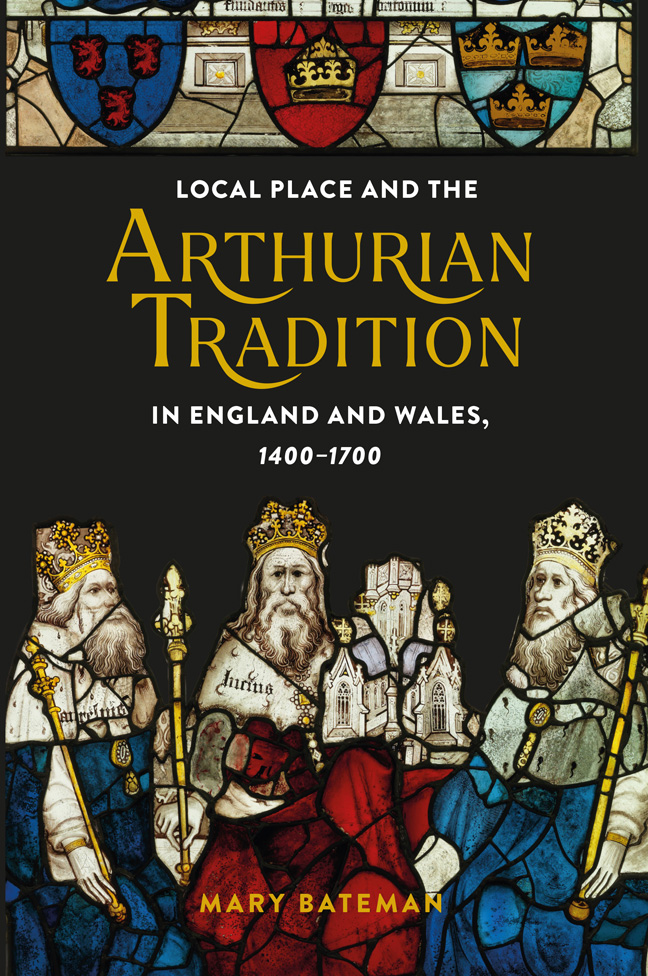Book contents
- Frontmatter
- Contents
- List of Illustrations
- Acknowledgements
- Introduction: Place and the defence of Arthur
- 1 ‘Thise were his places and his habitacions’: Arthur in situ in the fifteenth century
- 2 Contentious places: Reconciling Arthurian places in the fifteenth century
- 3 The best of the west: John Leland's West Country Arthur
- 4 Locating Arthur in England and Wales: John Leland, John Prise, and Elis Gruffydd
- 5 Placing Arthur in William Camden's Britannia
- Coda: Arthur's local renaissance?
- Bibliography
- Index
- Miscellaneous Endmatter
5 - Placing Arthur in William Camden's Britannia
Published online by Cambridge University Press: 21 February 2024
- Frontmatter
- Contents
- List of Illustrations
- Acknowledgements
- Introduction: Place and the defence of Arthur
- 1 ‘Thise were his places and his habitacions’: Arthur in situ in the fifteenth century
- 2 Contentious places: Reconciling Arthurian places in the fifteenth century
- 3 The best of the west: John Leland's West Country Arthur
- 4 Locating Arthur in England and Wales: John Leland, John Prise, and Elis Gruffydd
- 5 Placing Arthur in William Camden's Britannia
- Coda: Arthur's local renaissance?
- Bibliography
- Index
- Miscellaneous Endmatter
Summary
The preceding chapters have traced local Arthurian histories from onsite experiences to national and universal chronicles and dedicated Arthurian defences. This chapter steps forward in time to consider a text that represents the apotheosis of Arthurian local representation: Britannia (1586), authored by the celebrated Elizabethan antiquary William Camden. I close with Camden because I want to draw out the continuities between the local Arthurian site histories of the fifteenth century and Camden's chorographical work, which is often treated as a departure from what has come before. Although Camden was a founding member of the Society of Antiquaries, he was not the first antiquarian, and Camden's antiquarian forbears have been touched upon in previous chapters. Some of these figures, such as John Leland, John Prise, and Humphrey Llwyd, were direct sources for Camden. Others, such as John Rous and John Hardyng, had an indirect impact on Camden's work because their writings were in turn vital sources for Leland, Prise, and Llwyd.
Arguably, these earlier antiquarians’ attempts to defend Arthur's native places also paved the way for Camden. There is little scholarship on Camden's attitude towards Arthur, but that which does exist claims that Camden was indifferent to or perhaps even ashamed of him. This is contradicted by Camden's presentation of Arthur throughout Britannia, by the text's editorial history and Camden's control over it, and by his selective use of poetic and historical sources. As a result, Camden was perhaps the first Arthurian defender to truly succeed in reviving Arthur's native locations in the public consciousness. This success was due to a number of related factors. First, the institutionalisation of antiquarianism during the reign of Elizabeth I made Camden and his work seem more authoritative than those who had come before. A second factor in Camden's success was his use of visual imagery in the form of woodcuts and engravings, which replicated the eyewitness experience of Arthur's places and relics more effectively than earlier Arthurian defences such as Leland's Assertio. These visual renderings were combined with poetic fragments that served the purpose of glorifying their subject matter by acting as textual memorials. By presenting these physical and textual artefacts within a chorographical structure, Camden succeeded in historicising Arthur where his antiquarian forbears had failed.
- Type
- Chapter
- Information
- Publisher: Boydell & BrewerPrint publication year: 2023



